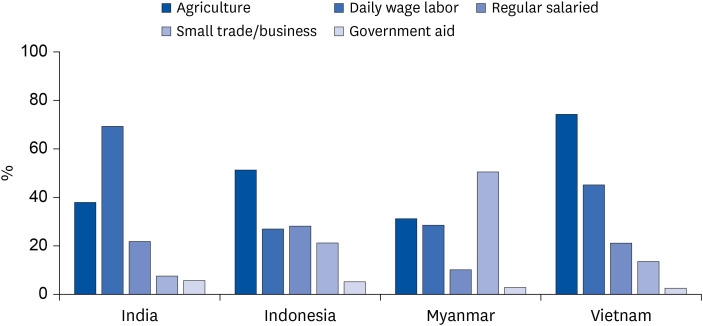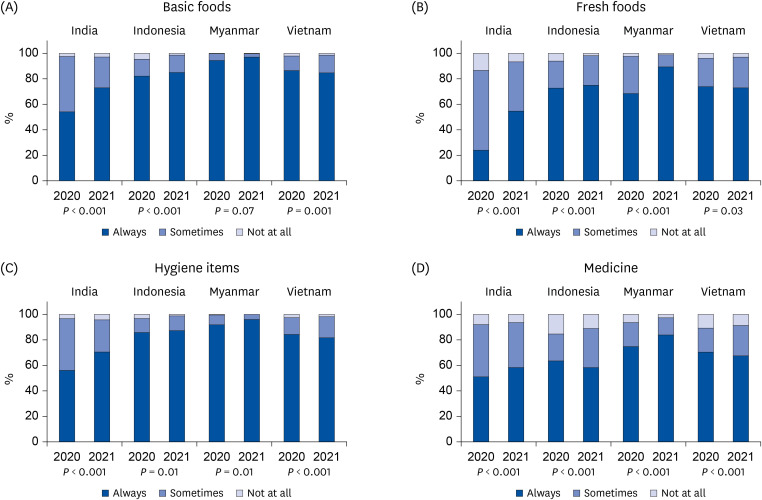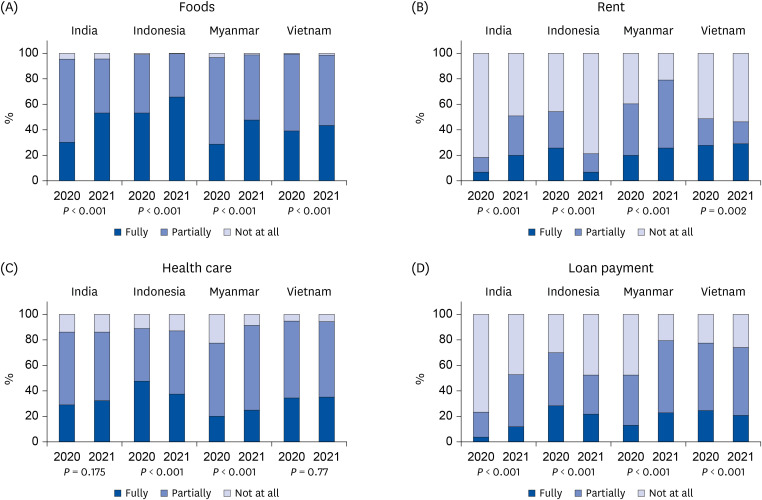Nutr Res Pract.
2024 Feb;18(1):149-164. 10.4162/nrp.2024.18.1.149.
Spatial and temporal trends in food security during the COVID-19 pandemic in Asia Pacific countries: India, Indonesia, Myanmar, and Vietnam
- Affiliations
-
- 1Department of International Health, Johns Hopkins Bloomberg School of Public Health, Baltimore, MD 21205, USA
- 2Johns Hopkins Bloomberg School of Public Health, Baltimore, MD 21205, USA
- 3Korea Rural Economic Institute, Naju 58321, Korea
- 4Department of Food and Nutrition, Seoul National University, Seoul 08826, Korea
- 5World Vision US, Seattle, WA 98118, USA
- KMID: 2552267
- DOI: http://doi.org/10.4162/nrp.2024.18.1.149
Abstract
- BACKGROUND/OBJECTIVES
The economic recession caused by the coronavirus disease 2019 pandemic disproportionately affected poor and vulnerable populations globally. Better uunderstanding of vulnerability to shocks in food supply and demand in the Asia Pacific region is needed.
SUBJECTS/METHODS
Using secondary data from rapid assessment surveys during the pandemic response (n = 10,420 in mid-2020; n = 6,004 in mid-2021) in India, Indonesia, Myanmar, and Vietnam, this study examined the risk factors for reported income reduction or job loss in mid-2021 and the temporal trend in food security status (household food availability, and market availability and affordability of essential items) from mid-2020 to mid-2021.
RESULTS
The proportion of job loss/reduced household income was highest in India (60.4%) and lowest in Indonesia (39.0%). Urban residence (odds ratio [OR] range, 2.20-4.11; countries with significant results only), female respondents (OR range, 1.40–1.69), engagement in daily waged labor (OR range, 1.54–1.68), and running a small trade/business (OR range, 1.66–2.71) were significantly associated with income reduction or job loss in three out of 4 countries (allP< 0.05). Food stock availability increased significantly in 2021 compared to 2020 in all four countries (OR range, 1.91–4.45) (all P < 0.05). Availability of all essential items at markets increased in India (OR range, 1.45–3.99) but decreased for basic foods, hygiene items, and medicine in Vietnam (OR range, 0.81–0.86) in 2021 compared to 2020 (all P < 0.05). In 2021, the affordability of all essential items significantly improved in India (OR range, 1.18–3.49) while the affordability of rent, health care, and loans deteriorated in Indonesia (OR range, 0.23–0.71) when compared to 2020 (all P < 0.05).
CONCLUSIONS
Long-term social protection programs need to be carefully designed and implemented to address food insecurity among vulnerable groups, considering each country’s market conditions, consumer food purchasing behaviors, and financial support capacity.
Keyword
Figure
Reference
-
1. Ahmed N, Marriott A, Dabi N, Lowthers M, Lawson M, Mugehera L. Inequality Kills: The Unparalleled Action Needed to Combat Unprecedented Inequality in the Wake of COVID-19. Oxford: Oxfam International;2022.2. World Health Organization (WHO). Global excess deaths associated with COVID-19, January 2020 - December 2021 [Internet]. Geneva: WHO;2022. cited 2022 May. Available from: https://www.who.int/data/stories/global-excess-deaths-associated-with-covid-19-january-2020-december-2021.3. Bottan NL, Hoffmann B, Vera-Cossio DA. The Unequal Burden of the Pandemic: Why the Fallout of COVID-19 Hits the Poor the Hardest. Washington, D.C.: Inter-American Development Bank;2020.4. Ferreira FHG. INEQUALITY in the time of COVID-19: all metrics are not equal when it comes to assessing the pandemic’s unequal effect. Finance Dev. 2021; (June):20–23.5. Food and Agriculture Organization (FAO). International Fund for Agricultural Development (IFAD). United Nations International Children’s Emergency Fund (UNICEF), World Food Programme (WFP), World Health Organization (WHO). The State of Food Security and Nutrition in the World 2021: Transforming Food Systems for Food Security, Improved Nutrition and Affordable Healthy Diets for All. Rome: FAO;2021.6. Osendarp S, Akuoku JK, Black RE, Headey D, Ruel M, Scott N, Shekar M, Walker N, Flory A, Haddad L, et al. The COVID-19 crisis will exacerbate maternal and child undernutrition and child mortality in low- and middle-income countries. Nat Food. 2021; 2:476–484. PMID: 37117686.7. Béné C. Resilience of local food systems and links to food security - a review of some important concepts in the context of COVID-19 and other shocks. Food Secur. 2020; 12:805–822. PMID: 32837646.8. Vatta K, Bhogal S, Green AS, Sharma H, Petrie CA, Dixit S. COVID-19 pandemic-induced disruptions and implications for national food security and farm incomes: farm-level evidence from Indian Punjab. Sustainability (Basel). 2022; 14:4452.9. United Nations World Food Programme (UNWFP). Department of Food and Public Distribution (DFDP). Ministry of Consumer Affairs, Food & Public Distribution (MoCAF&PD). Government of India (GOI). Food Security Response during COVID-19 and PDS Best Practices in Some States/UTs. New Delhi: WFP;2021.10. Trading Economics. India food inflation [Internet]. place unknown: Trading Economics;2022. cited 2023 January 14. Available from: https://tradingeconomics.com/india/food-inflation.11. Nguyen T, Pham Thi Mai H, van den Berg M, Huynh Thi Thanh T, Béné C. Interactions between food environment and (un)healthy consumption: evidence along a rural-urban transect in Viet Nam. Agriculture. 2021; 11:789.12. Suryahadi A, Al Izzati R, Yumna A. The impact of Covid-19 and social protection programs on poverty in Indonesia. Bull Indones Econ Stud. 2021; 57:267–296.13. The World Bank. Myanmar Economic Monitor: Contending with Constraints. Washington, D.C.: The World Bank;2022.14. World Vision. Unmasking II - Childhood Lost. Uxbridge: World Vision;2021.15. Kang Y, Baidya A, Aaron A, Wang J, Chan C, Wetzler E. Differences in the early impact of COVID-19 on food security and livelihoods in rural and urban areas in the Asia Pacific Region. Glob Food Secur. 2021; 31:100580.16. Aday S, Aday MS. Impact of COVID-19 on the food supply chain. Food Qual Saf. 2020; 4:167–180.17. Kakaei H, Nourmoradi H, Bakhtiyari S, Jalilian M, Mirzaei A. Chapter One - Effect of COVID-19 on food security, hunger, and food crisis. Dehghani MH, Karri RR, Roy S, editors. COVID-19 and the Sustainable Development Goals. New York (NY): Elsevier;2022. p. 3–29.18. Barman A, Das R, De PK. Impact of COVID-19 in food supply chain: disruptions and recovery strategy. Curr Res Behav Sci. 2021; 2:100017.19. Das S, Rasul MG, Hossain MS, Khan AR, Alam MA, Ahmed T, Clemens JD. Acute food insecurity and short-term coping strategies of urban and rural households of Bangladesh during the lockdown period of COVID-19 pandemic of 2020: report of a cross-sectional survey. BMJ Open. 2020; 10:e043365.20. Headey D, Goudet S, Lambrecht I, Maffioli EM, Oo TZ, Russell T. Poverty and food insecurity during COVID-19: phone-survey evidence from rural and urban Myanmar in 2020. Glob Food Secur. 2022; 33:100626.21. Padmaja R, Nedumaran S, Jyosthnaa P, Kavitha K, Abu Hatab A, Lagerkvist CJ. COVID-19 impact on household food security in urban and peri-urban areas of Hyderabad, India. Front Public Health. 2022; 10:814112. PMID: 35646805.22. Adams-Prassl A, Boneva T, Golin M, Rauh C. Inequality in the impact of the coronavirus shock: evidence from real time surveys. J Public Econ. 2020; 189:104245.23. Bateman N, Ross M. The pandemic hurt low-wage workers the most—and so far, the recovery has helped them the least [Internet]. Washington, D.C.: Brookings;2021. cited 2023 January 14. Available from: https://www.brookings.edu/articles/the-pandemic-hurt-low-wage-workers-the-most-and-so-far-the-recovery-has-helped-them-the-least/.24. Makkar S, Manivannan JR, Swaminathan S, Travasso SM, John AT, Webb P, Kurpad AV, Thomas T. Role of cash transfers in mitigating food insecurity in India during the COVID-19 pandemic: a longitudinal study in the Bihar state. BMJ Open. 2022; 12:e060624.25. Lee K, Kim S, Kim B. A Study on Enhancing the National Agri-food Assistance System for Low-income Households. Naju: Korea Rural Economic Institute;2017.26. Press Information Bureau (PIB). Government of India, Ministry of Consumer Affairs, Food & Public Distribution. Government approves extension of Pradhan Mantri Garib Kalyan Anna Yojana (PM-GKAY), from July 2021 up to November, 2021. Delhi: PIB;2021.27. Press Information Bureau (PIB). Finance Minister announces Rs 1.70 Lakh Crore Relief Package under Pradhan Mantri Garib Kalyan Yojana for the Poor to Help Them Fight the Battle against Corona Virus. Delhi: PIB;2020.28. Thurow LC. Cash versus in-kind transfers. Am Econ Rev. 1974; 64:190–195.29. Bodamaev S, Tuwo A. COVID-19 Economic and Food Security Implications for Indonesia. 4th ed. Rome: World Food Programme;2020.30. Akbar A, Darma R, Fahmid IM, Irawan A. Determinants of household food security during the COVID-19 pandemic in Indonesia. Sustainability (Basel). 2023; 15:4131.31. Syafiq A, Fikawati S, Gemily SC. Household food security during the COVID-19 pandemic in urban and semi-urban areas in Indonesia. J Health Popul Nutr. 2022; 41:4. PMID: 35189982.32. Headey DD, Oo TZ, Mahrt K, Diao X, Goudet S, Lambrecht I. Poverty, food insecurity, and social protection during COVID-19 in Myanmar: Combined evidence from a household telephone survey and micro-simulations. Washington, D.C.: International Food Policy Research Institute;2020.33. UN News. Number of internally displaced in Myanmar doubles, to 800,000 [Internet]. San Francisco (CA): United Nations;2022. cited 2023 January 14. Available from: https://news.un.org/en/story/2022/02/1111812.34. Krishna G, Howard S; freelance journalist. freelance journalist. Myanmar doctors are under fire from the military and covid-19. BMJ. 2021; 375:n2409. PMID: 34625451.35. World Food Programme (WFP). WFP Myanmar External Situation Report #2 (June 2021) [Internet]. Rome: WFP;2021. cited 2023 January 14. Available from: https://www.wfp.org/publications/wfp-myanmar-external-situation-report-2-june-2021.36. Food and Agriculture Organization (FAO). World Food Programme (WFP). Myanmar | Agricultural livelihoods and food security in the context of COVID-19: Monitoring report - May 2021 [Internet]. Rome: FAO;2021. cited 2023 January 14. Available from: https://www.fao.org/documents/card/en/c/cb5218en.37. Goudet S, Hlaing LM, Griffiths PL. Exploring food security and nutrition among young women in the formally regulated garment sector of Myanmar. Ann N Y Acad Sci. 2020; 1468:35–54. PMID: 32396663.38. Myanmar Now. Government to give free food to jobless during Thingyan [Internet]. Yangon: Myanmar Now;2020. cited 2022 May 1. Available from: https://myanmar-now.org/en/news/government-to-give-free-food-to-jobless-during-thingyan/.39. Myanmar Agriculture Policy Support Activity (MAPSA). Livelihoods, poverty, and food insecurity in Myanmar: Survey evidence from June 2020 to December 2021. Myanmar SSP Research Note. Washington, D.C.: International Food Policy Research Institute (IFPRI);2022.40. United Nations (UN). COVID-19 Socio-economic Response Plan for Viet Nam. San Francisco (CA): UN;2020.41. The World Bank. A Year Deferred - Early Experiences and Lessons from Covid-19 in Vietnam. Washington, D.C.: The World Bank;2021.42. Aaron A, Baidya A, Wang J, Chan C, Wetzler E, Kang Y. The early impacts of COVID-19 on food security and livelihood in Vietnam. Front Sustain Food Syst. 2021; 5:739140.
- Full Text Links
- Actions
-
Cited
- CITED
-
- Close
- Share
- Similar articles
-
- The management of food allergy in Indonesia
- Insights and pearls of healthcare systems management of COVID-19 in Asia and its relevance to Asian transplant services
- Food service industry in the era of COVID-19: trends and research implications
- Impact of the Coronavirus Disease 2019 Pandemic on Pediatric Gastrointestinal Endoscopy: A Questionnaire-based Internet Survey of 162 Institutional Experiences in Asia Pacific
- Lockdowns, Community Mobility Patterns, and COVID-19: A Retrospective Analysis of Data from 16 Countries





